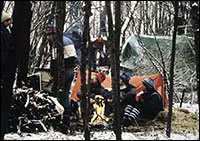 |
Revisiting Hainburg
|
 |
Protesters brave chilly winter
nights to hold their ground in the fight against the Hainburg power
plant in December 1984. |
In the 1970s, plans for a new power plant east of Vienna became public and a few citizens recognised that this would destroy riverine forests. These dedicated citizens began to inform the local population as well as politicians and environmental groups. Ecological scientists soon joined the protest, in particular Austrian Nobel prizewinner Professor Konrad Lorenz. The World Wide Fund for Nature, WWF, joined by other concerned organisations, formed an action committee against the Hainburg power plant in June 1983.
Unknown treasure.
The first challenge for activists was to acquaint the
general public with the unique beauty of the area.
Several playful actions drew publicity for the movement;
celebrities dressed as endangered animals for
an animal press conference and rowing teams from
Oxford and Cambridge held an awareness regatta on the Danube. The international
president of WWF, HRH Prince Philip, Duke of Edinburgh, came to emphasise
the international importance of the area and to appeal for its protection.
Cold days in December.
The first protestors came to the forest in early December, followed by construction
workers and police units. The protestors built human barricades and remained
peaceful, although many were injured when the police attacked protestors
as the first trees were cut.
Protestors sent pictures around the world and public awareness increased
dramatically. Those who could not join in the protest sent letters, money,
food and equipment. For Wolfgang Pekny of Greenpeace in Central and Eastern
Europe, “Hainburg was the most formative event of the environmental
movement in Austria. And for me personally it was the best self-organized
mass event I have ever seen and most probably will ever see.”
A long way to protection.
By Christmas, the government proclaimed a ‘reflecting pause’
and in early 1985 the highest administrative court ruled on a legal claim
filed by WWF and reversed the permission-decree of the water right authority.
However, it would take twelve more years and two WWF campaigns until the
area gained long-term protection as a national park.
The battle is not over yet. The Danube east of Vienna is threatened by traffic
projects in the national park and riverbed digging from the Bavarian stretch
to theUkrainian delta in the name of inland navigation.
WWF continues its efforts in the Danube region, using the Hainburg momentum
to inspire new activists. Ulrich Eichelmann, WWF Austria’s Danube
Coordinator, looks back on the protests as only a starting
point: “The Hainburg movement of 1984 hopefully inspires the Danube
movement of 2004 — since there are still threats to the whole river
from its source to the delta.”